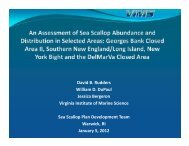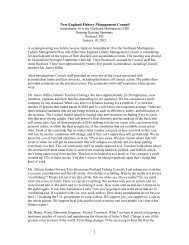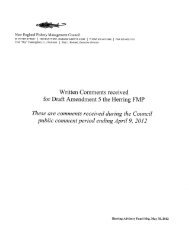Correspondence/Amendment 5 Comments - New England Fishery ...
Correspondence/Amendment 5 Comments - New England Fishery ...
Correspondence/Amendment 5 Comments - New England Fishery ...
Create successful ePaper yourself
Turn your PDF publications into a flip-book with our unique Google optimized e-Paper software.
M.C.Tynell et al. / Fisheríes Research 108 (201 1 ) 1-8<br />
stocks(Bogstadetal., 1997;OverholtzandLink,200T).Thisisalso large food habits database that in many respects allowed us to<br />
the case for seals in Atlantic Canada (Bowen et al., 2008, 2009), such do these calculations and think more broadly about these types of<br />
that concerns over seal predation on fish stocks have led to calls for approaches. Those efforts made the explicit incorporation of preseal<br />
culls to allow various fish species to escape from a "preda- dation for models of the northeast US ecosystems possible. The<br />
tor pit" that may be regulating the abundance of these stocks. In content of this paper benefited from comments provided by two<br />
the North Sea, herring are recovering from overfishing in the late anonymous reviewers. This work was supported by Lenfest Ocean<br />
1960s and their consumption of sandeel, Ammodytes marinus,lar- Program Grant Number 2004-001492-'105.<br />
vae may have led to food shortages for breeding seabirds (ICES,<br />
2007). Rebuilding predator populations, whether they are fisheries<br />
species; or protected, endangered or threatened marine mammals; References<br />
or other consumers such as seabirds, will affect the abundance of<br />
their prey (e.g., Punt and Butterworth, 1 995; Constable, 2001 ; ICES, Bjørnsson, H., sigurdsson, T., 2003. Assessment of golden redfish (seåasrus marinus<br />
2oo8).Failinstoaccounrrorthesetypesorpredatoryinrerl:tlon:in ,"rkìlT]if*:iiiiår;iliilYi;:lÍ:Ìtjl"t^t"1g[, Grobaily appricabre Areaestimating<br />
the stock recovery trajectory ofprey species will lead to "oísaggregat"¿<br />
ceneral EcosysremTootbox. rcEs cM zoo+¡rr:t:,þ. to.<br />
poor management advice such as overly optimistic recovery times Bogstad,8., Hauge, K.H., ulltang, Ø.,1997. MULTSPEC- A multi-species model forfish<br />
(rcES, reeT; Bjørnsson and sigurdsson, 2003; Moustahnd et ar, ,",$;åÏ.nü:äüiìili1lTJ:å::fi:j:":lid;)lilX-,ilix!!i:il;iÊí:Ji;'il<br />
2009b). As an example, Harvey et al. (2008) found that by incor- ---îiün"".oryrtems.Nature277,sge-sls.<br />
porating predation by Pacific hake, Merluccius productus, on widow Proceedings of the National workshop on the Impãcts of seals on Fish Populations in<br />
rockfish, Sebas tes entomelas,there were significant increases in the Eastern canada. 12-16 November (Part 1) Bowen, w.D', Hàmmill, M'o., Koen-<br />
DFo cànadian<br />
median rime ro rebuud widow rocknsh popurations. ålälik,liîä*";;i,iJiÏ;3"å;,iåü!i,[';i;áåli.)¡r'il8'<br />
3. Conclusions<br />
We assert that the need to consider species interactions in<br />
fisheries management has been reasonably documented here<br />
and elsewhere (e.g., Hollowed et al., 2000; Jurado-Molina and<br />
Livingston, 2002). We recognize that the influence of predation<br />
mortality for estimating abundance is more important for some fish<br />
species than others. But we trust that the exemplary case studies<br />
we have shown highlight the importance of considering predation<br />
for at least some marine fish species. The methods to incorporate<br />
predation mortality into quantitative determinations of BRPs exist<br />
across a wide range of applications. The concerns over increasing<br />
precisional uncertainty by including predatory considerations are<br />
largely offset by improvements such inclusions provide to process<br />
and accuracy uncertainties. None ofwhat we point out is singularly<br />
novel, but what we have collectively documented is how important<br />
including M2 can be, especially for forage species.<br />
An ecosystem based approach to fisheries management calls for,<br />
among other things, a "best practice" approach for BRP calculations.<br />
Population dynamics models that explicitly include predation mortality<br />
indicate that BRPs that treat overall natural mortality as<br />
low and constant through time result in management advice that<br />
is overly optimistic. We show that a wide variety of modeling<br />
approaches have produced BRPs that are more conservative when<br />
predation mortality is explicitly incorporated in prey abundance<br />
calculations. For a strongly interacting predator prey complex (e.g.,<br />
cod, herring and sprat in the Baltic) simultaneously achieving MSY<br />
as determined by single-species methods has been deemed impossible<br />
(ICES, 2008; sensu NEFSC, 2008; sensu Worm et al., 2009).<br />
Explicitly adopting the more conservative reference points will<br />
not insure sustainability of the fisheries for forage species in and<br />
of itself. Nevertheless, we recommend that these revised reference<br />
points be presented as part of the package of management<br />
informing advice because they represent an easily implemented<br />
component of EBFM, account for more factors that can affect a<br />
stock, and represent a precautionary approach. More so, we conclude<br />
by noting that the need to do them is apparent, the tools to do<br />
so are extant, and the consequences ofcontinuing to ignore these<br />
considerations could be problematic.<br />
Acknowledgments<br />
We extend our appreciation to the present and past members<br />
of the Food Web Dynamics Program for their maintenance of a<br />
Proceedings ofthe National workshop on the tmpacts ofseals on Fish Populations in<br />
Eastern Canada. Fisheries and Oceans Canadå, Halifax, November 24-28 (Part 2)<br />
8owen,w.D., Hammill, M.O., Koen-Alonso, M., Stenson, G., Swain, D.P.,Trzcinski,<br />
K. (Eds.), 2009. DFO Canadian Science Advisory Secretariat Proceedings Series<br />
2009, p.020.<br />
Brodziak,J., Cadrin, SX., Legåult, C.M., Murawski, S.4.,2008. Goãls and strãtegies for<br />
rebuilding <strong>New</strong> <strong>England</strong> groundfish stocks. Fish. Res.94,355-366.<br />
Browman, H.1., Stergiou, K.1.,2004. Perspectives on ecosystem based approaches to<br />
the management ofmarine resources. Mâr. Ecol. Prog. Ser.274,269-3O3.<br />
Collie,J.S., Delong,4.K., 1999, Multispecies interactions in the Georges Bank fish<br />
community. EcosystemApproaches for Fisheries Management,AlaskaSeaGrant<br />
College Symposium, AK-SG-99-01.<br />
Collie,J.S., Gislãson, H.,2001. Biological r€ference points for fish stocks in a multispecies<br />
context. can.J. Fish. Aquat. sci.58,2167-2776.<br />
Constable, AJ.,2001.The ecosystem approach to managing fisheries: achieving conservation<br />
objectives for predators of fished species. CCAMLR (Commission for<br />
the Conservation ofAntarctic Marine Living Resources). Science 8,37-64.<br />
Constable, AJ., de la Mare, W.K., Agnew, DJ., Everson, I., Miller, D.,2000. Managing<br />
fisheries to conserve the Antarctic marine ecosystem: practicãl implementation<br />
of the Convention on the Conservation of Antarctic Marine Living Resources<br />
(CCAMLR). ICESJ. Mar. Sci. 57, 778-791.<br />
Everson, I., de Ia Mare, W.K., 1996. Some thoughts on precautionary measures for<br />
the krill fishery. CCAMLR Sci. 3, 1-1 1.<br />
Fulton, E,4,, Smith, A.D.M., Smith, D,C., 2007. Altern¿tive Management Strategies for<br />
Southeast Australian Commonwealth Fisheries: Stage 2: Quantitative Management<br />
Strategy Evaluation. Australian Fisheries Management Authority Report,<br />
Canberra, Australia.<br />
camble, RJ., Link, J.S., 2009, Analyzing the tradeoffs among ecologicâl and fishing<br />
effects on an example fish community: a multispecies (fisheries) production<br />
model. Ecol. Model. 22O, 257 0-2582.<br />
GarciaS.M.,ZerbiA., AliaumeC., Do ChiT., Lasserre G.,2003.The ecosystem approach<br />
to fisheries. Issues, terminology, principles, institutional foundations, implementation<br />
ãnd outlook. FAO Fisheries Technical Paper. No.443. Rome, FAO.<br />
Gãrrison, L.P., Link,J.S.,2OO4. An expanded multispecies virtual population analysis<br />
(MSVPA-X) to evaluate predator-prey interactions in exploited fish<br />
ecosystems. In: User's Manual and Model Description, Version 1. 1. Atlantic<br />
States Marine Fisheries Commission (accessed November 2008) www. asmfc.<br />
org/researchstãtistics/msvpa-X-DocumentationJune03. pdf.<br />
Garrison, 1.P., Link,J.S., Cieri, M., Kildufl P., Sharov,4., Vaughan, D., Muffley, 8., Mahmoudi,<br />
8., Làtour, R., 2010.4n Expansion of the MSVPAApproach forQuantifoing<br />
Predator-Prey Interactions ln Exploited Fish Communities. ICES J. Mar. Sci. 67,<br />
8s6-870.<br />
Gislason, H., 1999. Single and multispecies reference points for Baltic fish stocks.<br />
ICES J. Màr. Sci. 56, 571 -583.<br />
Gislason, H., Helgason,T., 1985. Species interaction in assessment ofnsh stocks with<br />
special application to the North sea. Dana 5,1-44.<br />
cjøsæter, H., Bogstad, B., ljelmeland, S., 2002. Assessment methodology for Barents<br />
Sea capelin, Mallons villosus (Müller). IcEs J. Mar. sci. 59, 1086-1095.<br />
Hall, SJ,, 1999. Managing fisheries within ecosystems: can the role of reference<br />
points be expanded? Aquat. Conserv. I (6),579-583.<br />
Harvey, cJ., Gross, K., Simon, V.H., Hastie, J., 2008. Trophic and fishery interactions<br />
between Pacific hake and rockfish: effecton rockfish population rebuilding<br />
times. Mar. Ecol. Prog. Ser,365, 165-176.<br />
Hilborn, R., 2006. Faith-bãsed fisheries. Fisheries 31, 554-555.<br />
Hjermann, D.ø., Ottersen, G., Stenseth, N.C., 2004. Competition among fishermen<br />
and ñsh causes the collapse ofBarents Sea câpelin. Proc. Natl. Acad. Sci. U.S.A.<br />
101 (32),11679-11684.<br />
Hollowed, 4.8., Ianelli, J.N., Livingston, P.4., 2000. Including predation mortality in<br />
stock assessments: a case study for Gulf ofAlaska walleye pollock. ICES J. Mar.<br />
Sci.57,279-293.







